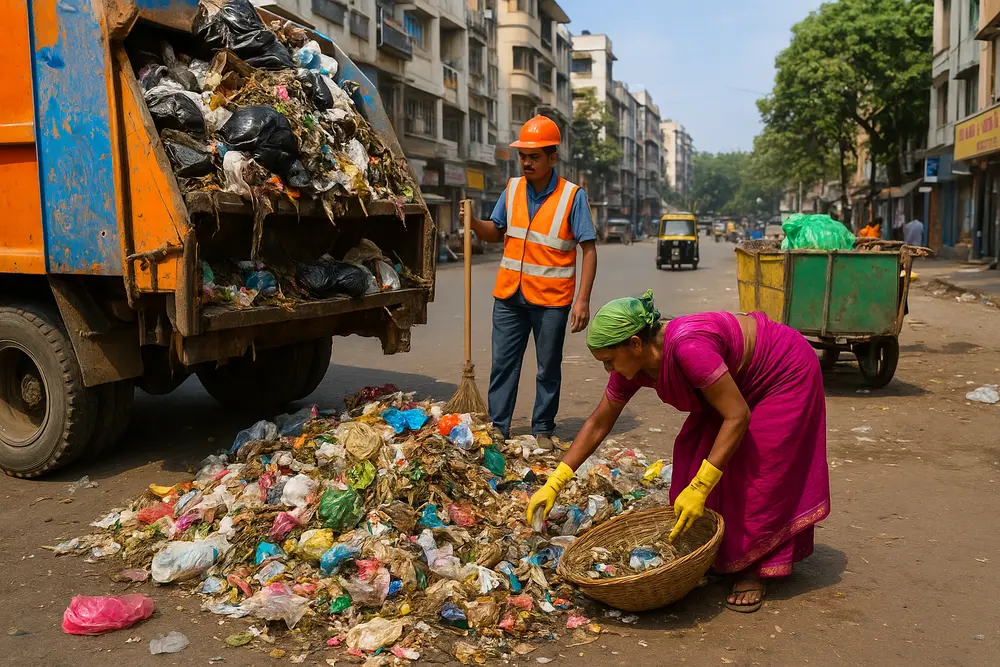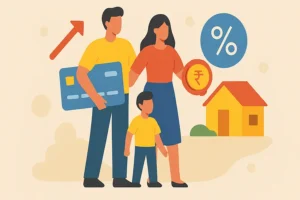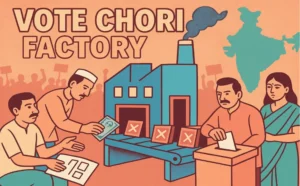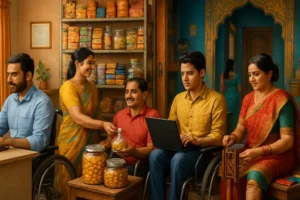Waste management in Indian cities is at a critical juncture—facing mounting pressure from population growth, consumption patterns, and environmental degradation.
Overflowing landfills, plastic-choked drains, and smoky dumpsites—this is the urban reality India must urgently tackle.
With cities generating over 160,000 tonnes of waste daily, waste management has become one of the biggest challenges of 2025. Yet, it also presents an incredible opportunity.
Imagine a future where garbage is transformed into energy, recycling creates green jobs, and every household proudly segregates waste. The question is no longer why we must act, but how.
Let’s explore the smart, sustainable, and people-powered solutions that can reshape waste management in Indian cities for a cleaner, greener tomorrow.

What are the Solutions to Improve Waste Management in Indian Cities in 2025?
Indian cities face mounting waste management challenges due to rapid urbanization, inadequate infrastructure, and low public awareness.
Overflowing landfills, poor segregation, and informal sector reliance hinder progress. However, emerging tech, decentralized systems, and circular economy models offer hope.
Addressing these issues requires smart policies, citizen participation, and innovative solutions to build cleaner, more sustainable urban environments.
In this article, we will dive deep into waste management in Indian cities and its solutions India needs in 2025 and beyond to fix its waste management system—solutions that involve not just governments, but also businesses, communities and everyday citizens like us.
Why Waste Management in Indian Cities Matters in 2025
Imagine walking through a city where garbage mountains loom taller than monuments, drains are clogged with plastic, and toxic smoke rises from burning dumps. Unfortunately, this isn’t fiction—it’s daily life in many Indian cities.
In 2025, waste management in Indian cities is no longer just a municipal headache; it’s a matter of public health, environmental survival, and urban dignity.
From plastic waste clogging drains during monsoons to untreated biomedical waste after the COVID-19 pandemic, urban India is facing a solid waste management crisis.
India’s cities are growing faster than ever. India generated about 170,000 tonnes of municipal solid waste daily, of which approximately 156,000 tonnes were collected, but only about a third is treated scientifically. About 54% of collected waste was treated, while ~24% was sent to landfills and ~22% remained unaccounted.
The rest ends up in overflowing landfills like Ghazipur in Delhi or Deonar in Mumbai, which leak toxins into the air and groundwater.
Poor waste handling fuels diseases like dengue, malaria, and respiratory infections, putting millions at risk.
At the same time, urban lifestyles are changing. Online shopping, single-use packaging, and fast fashion have multiplied the waste footprint. Add to that the challenge of biomedical and electronic waste, and you have a crisis that affects every household. If ignored, the costs of waste management in Indian cities—flooding, pollution, and health emergencies—will outweigh any economic growth India achieves.
But here’s the hopeful side: waste is not just a problem; it’s also a resource waiting to be tapped. Organic waste can become biogas or compost. Plastics can be recycled into fuel or raw material.
With proper segregation, technology, and citizen participation, waste can fuel a circular economy, create jobs, and even power cities.
2025 marks a turning point. India’s urban population is set to cross 600 million by 2030, and how cities handle waste today will decide whether they remain livable tomorrow.
Effective waste management in Indian cities isn’t just about keeping streets clean—it’s about building resilient, climate-friendly, and healthier cities for the next generation.
The Current Waste Management Challenges in Indian Cities
India’s urban waste management system is facing a perfect storm of challenges—driven by rapid urbanization, changing consumption patterns, and infrastructural gaps.
Before we talk about solutions, let’s understand the roadblocks:
- Rapid Urban Growth: India’s urban population is expected to reach 600 million by 2030, creating more waste than ever before. Cities simply don’t have the infrastructure to cope.
- Landfill Crisis: India has more than 3,000 dumpsites, and most have exceeded their capacity. For example, the Ghazipur landfill in Delhi is taller than the Qutub Minar.
- Poor Waste Segregation: Around 70% of Indian households still dump wet and dry waste together, making recycling nearly impossible.
- Informal Sector Overlooked: Over 1.5 million ragpickers play a crucial role in recycling but remain unrecognized, underpaid, and unprotected.
- Awareness Gaps: Many citizens still treat garbage disposal as “someone else’s job,” leading to low compliance with segregation rules.
- Policy & Finance Issues: Municipal corporations spend up to 60–70% of their waste budget on collection and transport, leaving little for treatment and recycling.
These challenges show why a new approach is urgently needed in 2025—one that combines policy reform, technology, and people’s participation.
Government Initiatives and Policies (2014–2025)
India hasn’t been silent on the waste crisis—several policies and programs have been rolled out in the last decade. Some have worked well, while others are still catching up. Let’s take a quick look:
Swachh Bharat Mission (SBM) & SBM 2.0 (2014–2025):
Launched in 2014, the Swachh Bharat Mission focused on cleanliness and sanitation. Its second phase (SBM 2.0) emphasizes sustainable waste management in Indian cities and villages—from segregation to processing. By 2024, the mission reported 85% door-to-door collection coverage across urban India, though segregation still lags behind.
Solid Waste Management Rules (2016, amended 2020 & 2023):
These rules made waste segregation at source mandatory, pushed for decentralized composting, and assigned responsibility to bulk waste generators (like hotels and apartments). The 2023 amendments tightened norms for construction and demolition waste, a big urban polluter.
Extended Producer Responsibility (EPR):
EPR policies require companies that make plastic packaging to collect and recycle it. By 2025, India aims to recycle 80% of its plastic packaging waste, a huge step toward a circular economy.
Smart Cities Mission:
Over 100 cities under this mission have adopted tech-driven waste solutions like smart bins, GPS tracking of garbage trucks, and data dashboards for monitoring collection.
State-Level Innovations:
- Kerala’s Haritha Karma Sena: A women-led network managing household waste.
- Maharashtra’s plastic ban (2018): Reduced single-use plastics significantly in urban areas.
- Indore’s waste model: Consistently ranked as India’s cleanest city due to strong enforcement + citizen engagement.
These policies provide a foundation—but the real question is: how do we move from rules on paper to results on the ground? That’s where the 2025 solutions come in.
Solutions to Improve Waste Management in Indian Cities in 2025 and Beyond
India’s waste management landscape is undergoing a much-needed transformation—and the momentum is building. Here’s a forward-looking blueprint of smart, scalable, and sustainable solutions that cities and communities are embracing to tackle the crisis head-on:
Segregation at Source – The First Step
Introduce and enforce a 3-bin system (wet, dry, hazardous). Provide incentives (discounts on property tax) for compliant households. Penalize non-segregation by bulk waste generators.
Success Story: Indore ensures 100% segregation at source with strict monitoring + awareness drives.
Technology-Driven Waste Management
Use smart bins with IoT sensors to send alerts when full, helping municipalities optimize waste collection routes and reduce fuel, time, and overflow-related inefficiencies.
Deploy robotic systems to automate sorting of recyclables, improving material recovery rates, reducing manual labor risks, and streamlining operations in urban waste processing facilities.
Establish waste-to-energy plants to convert non-recyclable waste into electricity, ensuring strict emission controls to prevent air pollution and meet environmental safety standards.
Install biogas and composting units for organic kitchen waste; replicate Bengaluru’s community biogas model to generate clean energy and reduce landfill pressure.
Strengthening the Role of the Informal Sector
Acknowledge ragpickers as “safai mitras,” issue official ID cards, grant legal recognition, and empower them with dignity, respect, and rightful identity within India’s formal waste management system.
Offer comprehensive health insurance, conduct safety and recycling training programs, and ensure fair, timely wages to protect ragpickers’ wellbeing, improve efficiency, and secure their socio-economic future.
Formally integrate ragpickers into Material Recovery Facilities, assign structured recycling roles, provide safety gear, and ensure skill-based tasks, maximizing resource recovery while safeguarding workers’ health and rights.
Public-Private Partnerships (PPP) and Corporate Role
Promote public-private partnership models, assign clear responsibilities, share risks and rewards, and enhance efficiency by involving private expertise in waste collection, processing, and recycling initiatives.
Utilize corporate CSR funds strategically, design impactful awareness campaigns, engage communities, and spread knowledge on waste segregation, reduction, and recycling to build sustainable urban waste management culture.
Provide financial incentives, mentorship, and policy support to startups innovating in recycling plastics, e-waste, and textiles, encouraging entrepreneurship while solving urban waste management challenges effectively.
Citizen Awareness and Behavioral Change
Launch impactful large-scale awareness campaigns, use digital platforms, street plays, and community events to educate citizens on waste segregation’s importance, encouraging responsible habits and sustainable daily practices.
Engage schools and Resident Welfare Associations actively, organize workshops, competitions, and awareness programs, instilling lifelong sustainable values in children and communities, fostering collective responsibility for waste management.
Introduce gamified reward systems, track household compliance digitally, award points, discounts, or recognition, motivating families to practice consistent segregation and making sustainability engaging, enjoyable, and rewarding.
Circular Economy and Recycling Models
Encourage industries to adopt eco-design principles, create recyclable products, minimize waste at production stage, and design packaging that supports circular economy while reducing environmental footprint.
Scale up plastic-to-fuel projects, invest in proven technologies, ensure strict emission standards, and convert non-recyclable plastics into energy, reducing landfill pressure and dependence on fossil fuels.
Upgrade Material Recovery Facilities with advanced sorting machines, skilled workforce, and digital tracking systems, boosting urban recycling rates and ensuring efficient recovery of valuable resources.
Decentralized Waste Management Solutions
Establish ward-level composting centers, process organic waste locally, reduce landfill burden, generate compost for agriculture, and create community-based sustainable models for efficient decentralized waste management.
Mandate and support apartment complexes to install composting units, manage organic waste internally, reduce transportation costs, and foster resident participation in decentralized, eco-friendly waste management practices.
Set up community recycling hubs in every zone, enable waste segregation, provide drop-off points, empower residents, and strengthen localized recycling networks for higher material recovery.
Policy Reforms and Stricter Enforcement
Implement strict fines for littering and non-segregation, ensure consistent enforcement, use surveillance systems, and discourage careless waste disposal through accountability, deterrence, and visible municipal action.
Legislate clear segregation and recycling quotas for companies, monitor compliance rigorously, reward sustainable businesses, penalize violators, and ensure industries adopt eco-friendly practices supporting circular economy goals.
Boost municipal budgets for waste infrastructure, prioritize modern facilities, strengthen waste treatment plants, improve collection systems, and allocate funds transparently to ensure efficient urban waste management.
Read Here: How Urbanization Is Changing Indian Tradition
Conclusion: Towards a Cleaner, Greener India
India’s waste problem may look overwhelming, but it is far from unsolvable. Cities like Indore and Pune have shown that with the right mix of technology, governance, and citizen participation, waste can be turned into a resource.
The roadmap for 2025 and beyond is clear:
- Segregate at source.
- Embrace technology.
- Empower informal workers.
- Strengthen policies and enforcement.
- Make citizens active partners in the mission.
If India can scale these solutions nationwide, our cities won’t just be cleaner—they’ll also be more sustainable, resilient, and livable. After all, a cleaner India isn’t just a dream—it’s a responsibility we all share.
Read Also: How to Improve Sanitation and Hygiene in Indian Slums





